If you don’t have a social media listening strategy, you’re missing out on some of the most valuable data available to help you build your business.
In fact, nearly two-thirds of marketers agree that the value of social listening has increased over the past year.
Social media listening tools allow you to get a clear idea of what customers and prospects think of you by analyzing what they say on social media. You can also find out what they think of the competition. This is incredible real-time market research if you know how to access it.
Social listening is the practice of monitoring social media channels for mentions of your brand, competitors’ brands, and related keywords.
With social listening, you can track every mention of your brand on social media in real time. This will give you valuable insight into how customers feel about your products or services, what their pain points are, and what they would like to see from you in the future.
But social listening isn’t just about tracking mentions of your brand. You can also use it to track competing brands, trending content, and analyze sentiment on topics related to your business.
This intelligent information can be used to inform everything from marketing and product strategy to customer service and support, helping you make smarter, data-driven decisions that will positively impact your business bottom line.
While listening to social media is a proactive way to monitor, analyze and respond to online conversations, social media monitoring is more reactive.
Social monitoring monitors mentions of specific brands and sends alerts whenever your brand is mentioned online. It is sometimes referred to as brand monitoring. This can be useful for responding quickly to any negative sentiment or complaints, but it doesn’t give you a general idea of what people are saying about your brand or industry.
Social listening, on the other hand, gives you a complete overview of all online conversations related to your brand, products, industry, and competitors. This holistic approach provides valuable information that can help you make strategic decisions about your marketing and social media strategy.
In short, if you want to stay on top of the latest trends and see what people are saying about your brand over time, you need a social listening strategy.
If you don’t listen to social media, you are creating your business strategy with your eyes closed. Real people are actively talking about your brand and your industry online. It’s in your best interest to know what they’re saying.
Simply put, if you care about your customers, you care about the information you can get from listening to social media. Here are a few ways social listening can benefit your business.
Understand Your Audience
Listening to social media will help you better understand what your audience wants from your brand.
For example, an existing customer might tweet how much they love your product. Or you may notice a conversation where people are looking for solutions that your product or service can provide.
In both cases, you can use this valuable feedback to improve your offer and make your customers happier.
Spotify has created an entire Twitter account around this idea. @SpotifyCares actively listens and responds to users with questions or concerns, and offers daily tips, tricks, and feature updates to its followers.
This way, they can provide world-class customer service, build loyalty, and improve their product all at the same time.
Sometimes you need to change something 🔄 Here’s how to change your Spotify Premium plan: https://t.co/8Jh9CRNVzm pic.twitter.com/LQXuRQQw9d
— SpotifyCares (@SpotifyCares) June 1, 2022
Business intelligence and product information
Monitoring industry discussions also provides a wealth of information about what is working and what is not for existing and potential customers.
This information is a goldmine for your customer support, product developers, and marketing teams.
For example, the Zappos social media team got important information here to pass on to the UX team:
Oh my god, I’m so sorry you’re having trouble using AfterPay + VIP Shipping! If you DM us or call us, we can look into it for you. 🤔
— Zappos.com (@Zappos) September 25, 2022
Why not change an existing product or add a feature to solve problems people are talking about? Perhaps what you learn will spark a new product idea.
Social listening can also help you learn about dissatisfaction with your current products and those of your competitors. Can you change products, deliveries, or campaigns to address customer concerns? If you do, tell people about it with a targeted marketing campaign.
Crisis management
Social listening lets you track moods in real time, so you can know at a glance if there’s a significant change in how much people are talking about you, or in the mood behind what they’re saying.
Missed breakfast at McDonald’s by two minutes pic.twitter.com/2LAo0gByPg
— ☻ (@lemongeo) October 19, 2022
It’s like an early warning system that alerts you to positive and negative changes in how your brand is perceived online.
If you’re getting more engagement than usual, look for reasons why. Your audience shares a lot of useful information about what they like and don’t like. These lessons can help guide your channel strategy.
If your mood has taken a turn for the worse, look at social media reviews to try and pinpoint the source of the change. While you’re doing this, look for lessons that could prevent a similar mistake in the future. This can help you deal with PR disasters before they get out of hand.
Customer Relations and Acquisition
People usually like it when you offer help with their problems. But strangers on the internet certainly don’t like it when brands enter their social conversations with intrusive ads.
While social listening can help you uncover questions and conversations about your industry on social platforms, it shouldn’t be seen as an opportunity to jump in and try to sell right away.
Instead, see the conversation you join via social listening as an opportunity to develop relationships with potential customers in your industry that you can develop in social selling relationships.
Yes, all of this. ESPECIALLY the third one 🦉 https://t.co/3QJ7IRlBDt
— Hootsuite 🦉 (@hootsuite) October 14, 2022
Communicate, connect and share useful information. This will help make your brand the best resource when it comes time to make a buying decision.
Cooperation opportunities
Monitoring social conversations about your industry will give you an idea of who the important creators and thought leaders are in your field. These are important people to communicate with. They can have a huge impact on how people treat you.
Remember, this is a two-way street. Supporting others in your industry increases the likelihood that they will support you in return. Instead of trying to invade an existing community, collaborate with people who are already prominent in the conversations you want to join.
Social listening will help you find ways to become part of relevant online communities organically and in a way that is perceived as helpful, not sales.
You will also find people who already love your brand and say nice things about you on social media. These are natural brand advocates. Reach out to them and look for opportunities for meaningful collaboration.
As stated in the Hootsuite trend report:
“If people in the community see you as an active partner in supporting creators they admire, they are more likely to believe that you have their best interests at heart as well.”
Competitors and industry trends
Social listening is about more than understanding what people are saying about you. You also want to know what they have to say about your competitors and your industry as a whole. This gives you important information about where you are in the market.
Social listening shows you what your competitors are doing in real time. Are they launching new products? Designing new social media marketing campaigns?
For example, when Wendy’s played around with the Facebook/Meta brand update, Arby’s was quick to step in:
Relax @Wendys 🥶 – We have meat 😉 https://t.co/64UnbhL3Zw
— Arby (@Arbys) October 28, 2021
Perhaps the conversations you find will open up a gap in the market that you could fill.
Detecting these new opportunities and threats as they arise allows you to plan and respond on the fly.
Uncover market trends
We all know how quickly the social media landscape is changing. What is viral today is obsolete the next day. Staying on top of these trends is important to keep your content strategy up to date and to ensure you don’t miss out on key discussions.
By tracking relevant keywords and hashtags related to your industry, you can keep up to date with the latest trends in your industry and stay ahead of the curve.
We’re so happy to hear that you’re enjoying it, Jan, and even more excited to have you as part of #TeamPixel! 🤩🙌
— Made by Google (@madebygoogle) October 18, 2022
You can also use social listening to predict future trends by analyzing not only what people are talking about now, but also how those conversations have changed over time. This will give you a good idea of which topics are gaining momentum and which ones are losing popularity.
This valuable insight can shape your content strategy, product development, and marketing campaigns.
Improve campaign targeting
Personalization is the key to any social advertising campaign. Your audience wants to feel like you’re talking directly to them, not just churning out generic content.
Social listening can help you better understand your target audience. You can find out what issues they care about, what language they use, and what content they like. Think of it like a survey that is always running in the background.
This insight will inform every aspect of your campaign, from copy to visuals, and help you create content that speaks directly to your audience.
- Are clients talking about social burnout? Create a work-life balance guide to show you care.
- Are people in your target area complaining about the weather? Organize a short-term sale of seasonal items.
- Seeing a spike in small business social media inquiries? Why not create an entire campaign to help them?
Once you know what you want to listen to, it’s time to start using some social listening platforms. Here are the best social listening tools you should be using.
1.Hootsuite
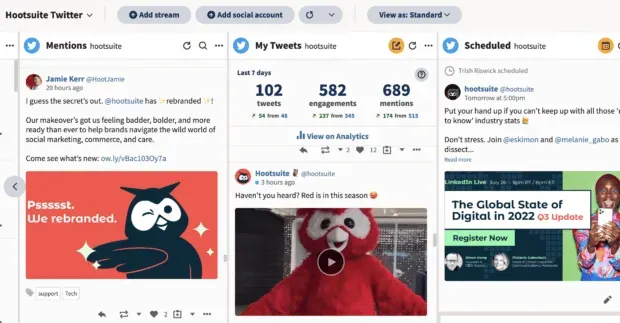
Even with the free or Pro plan, you can use Hootsuite to set up social media streams that track conversations, keywords, mentions, and hashtags.
You can also track and respond to conversations or mentions right away from your social media dashboard instead of having to log in and out of various social platforms.
Hootsuite also allows you to keep up to date with what’s happening in your industry by monitoring competition and building relationships with social media creators (also known as influencers) and potential brand advocates.
Social listening is one of the features Hootsuite customers love most about our product.
“Tipping point for marketers”
“…[with] streams you can quickly learn about any important activity on any and all platforms across all accounts without having to check each platform from each account; if someone retweets or mentions you, you will know as soon as possible and can respond accordingly.”
– Aachini H., Chief Financial Officer and Marketing Director
2. Hootsuite Insights by Brandwatch
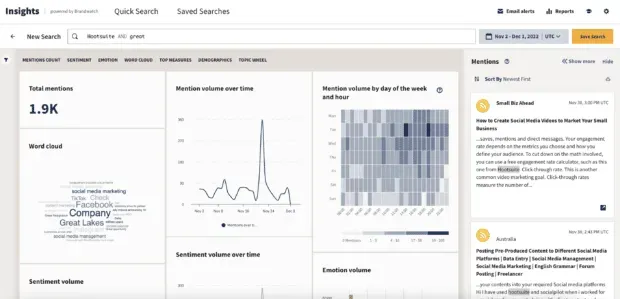
Do you want to become more advanced in listening to social networks? Hootsuite Insights takes listening a step further by giving you data on 16 billion new social media posts every month. Boolean search logic can help you find meaningful trends and patterns that you might miss by only tracking keywords and hashtags. You can then filter your search by date, demographics, and location to find the conversations that are most relevant to you.
Insights also makes it easy to track brand attitudes with intuitive word clouds and metrics that gauge your attitudes and brand awareness compared to your competitors.
3. Advertising
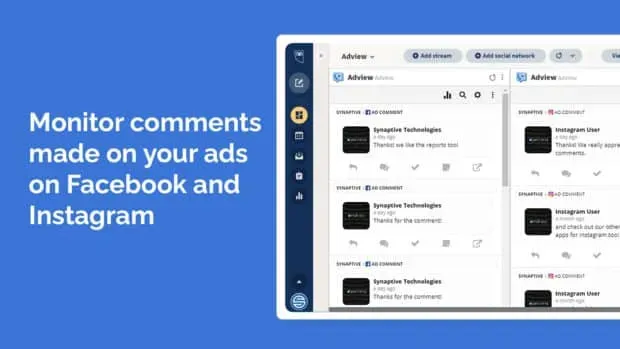
Unlike most social listening platforms, Adview is used specifically for social listening ads on Facebook and Instagram. You can use it to monitor up to three Facebook ad accounts on an unlimited number of pages.
Once you add Adview to your Hootsuite dashboard, you will be able to reply to comments on all your Facebook and Instagram ads in one place. Plus, you get detailed analytics on which ads get the most comments, so you can optimize your campaigns accordingly.
4. Phrasebook
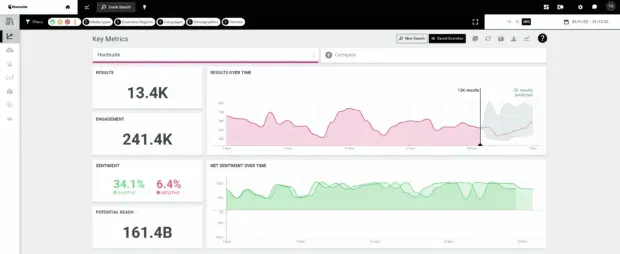
Talkwalker offers robust social listening software features that analyze blogs, forums, videos, news sites, review sites, and social networks in one pane. Talkwalker gets data from over 150 million sources.
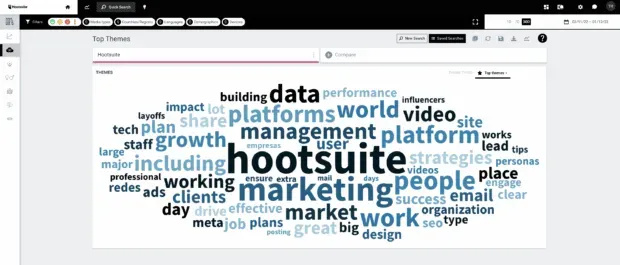
Advanced filters allow you to segment your data so you can focus on the messages and audiences that matter most to you. You can also set up alerts to notify you of any bursts of mentions or keywords.
With Talkwalker, you can easily track conversations about your brand by analyzing the engagement, reach, comments, and sentiment behind them.
5. Synthesio
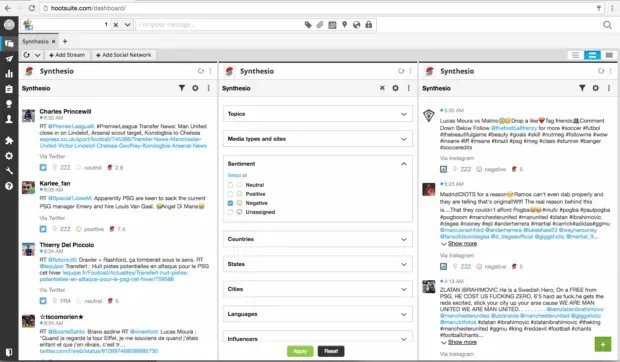
Synthesio is a social media listening tool that tracks conversations on very specific topics in a carefully segmented audience. It allows you to segment your social media listening data by language, location, demographics, mood, gender, influencer, and more.
The reports also include a handy social reputation score, so you know exactly where you stand compared to your competitors.
6. Mentions
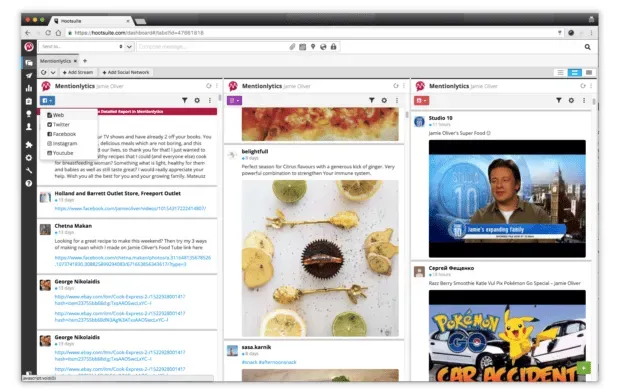
Track mentions, keywords, and sentiment in multiple languages with this social media listening tool. Mentionlytics’ social media monitoring tool scours social platforms as well as blogs and news sites for mentions. Because it’s integrated with Hootsuite, you’ll be able to easily view them in your dashboard.
Mentionlytics also makes it easy to find influencers on social media and other online sources. You can easily track who your top influencer is, track keywords in different languages, and even detect emotions in every mention.
7. Netbase Social Listening & Analytics
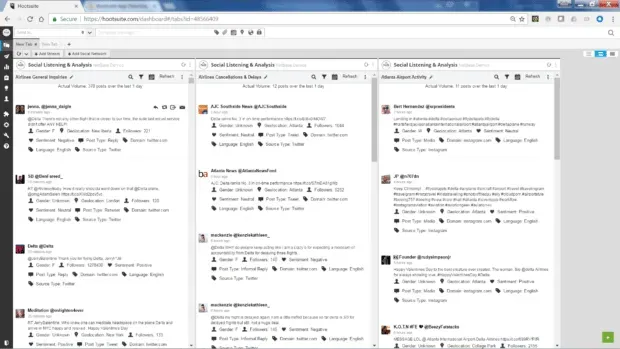
NetBase uses Natural Language Processing (NLP) to help you focus on key social media conversations. It collects data from hundreds of millions of social media posts daily, as well as over 100 billion historical social media posts.
With Netbase, you can create custom streams to focus on the topics that matter most to you. It’s also easy to moderate and participate in both your own and earned conversations.
In addition, Netbase can help you improve response times, curate content, strengthen support for brand advocates, channel opportunities down the sales funnel, and increase customer loyalty. And if you need help managing and resolving workflow internal issues, you can use NetBase’s assignments feature.
8. Audience
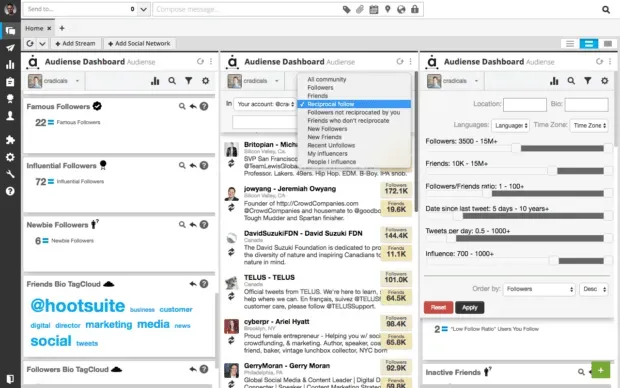
Audiense allows you to identify any audience, regardless of its size.
The app creates reports that tell you what your audience is discussing, what they like, and even how they think and behave. This information can be used to create marketing personas, understand changes in customer sentiment, and even drive product development.
Audiense’s social listening tool also provides automated organic and paid campaign tools so you can connect with your audience quickly and easily on the channels they prefer. Its Audience Manager also helps you discover and understand specific audiences to ensure your brand is perfectly matched.
9. Digital mind
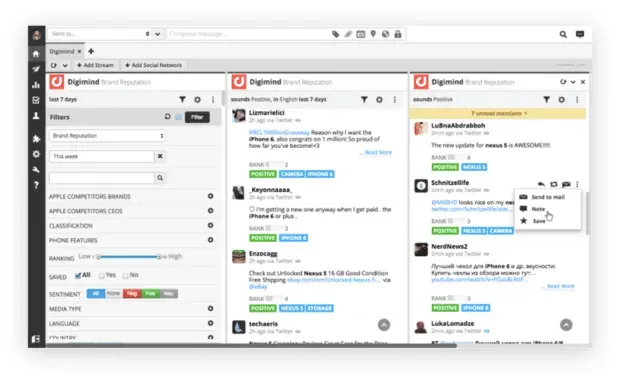
Digimind gets data from over 850 million sources in over 200 languages.
Using artificial intelligence, it analyzes mentions to track trends and sentiment, presenting them as useful data visualizations.
It also offers research services to help you understand your industry, competitors, and consumers. You can use the Digimind platform to track brand reputation and find new customers.
10. ForSight by Crimson Hexagon
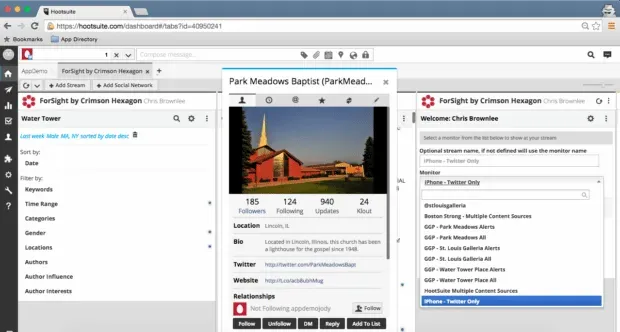
ForSight by Crimson Hexagon lets you filter social media listening streams by mood, opinion category, gender, geography, and impact score. With access to a data library of over 400 billion social media posts, it allows you to engage with large audiences in real time.
11. BrandMaxima Analytics
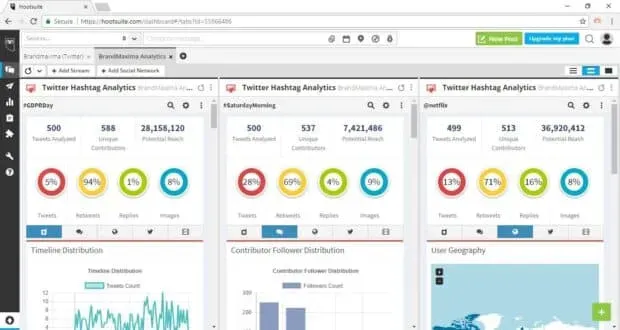
BrandMaxima Analytics offers Twitter analytics that allows you to track any hashtag, brand campaign, keyword or event in real time.
With over 50 insights and audience insights, it provides valuable data that can help improve the performance of any social media campaign.
You can also create stunning infographics within the app, so you’ll always be ready to present when it’s time for stakeholder engagement.
12. Klohok
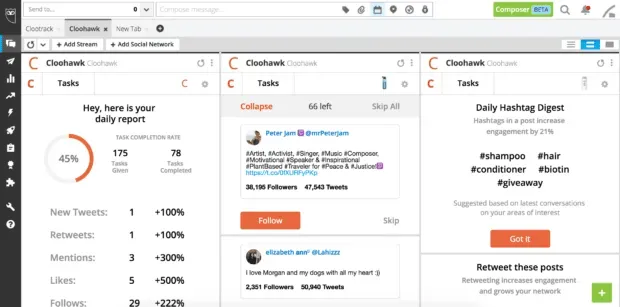
Cloohawk is the social listening tool you need to help expand and engage your target audience. By constantly analyzing your actions and target users, Cloohawk provides recommendations on how you can improve your social media engagement.
Cloohawk can help you track competitor profiles, identify growth opportunities, and suggest ways to reach your KPIs. Plus, the Cloohawk app seamlessly integrates with Hootsuite, so you don’t have to leave one app to open another.
13. Crowd analyzer
If you want to listen to multiple social channels at the same time, Crowd Analyzer is your tool. Crowd Analyzer tracks sentiment across channels including Facebook, Twitter, and Instagram. It also monitors online forums, news channels, and blogs to ensure your brand is heard no matter where the chatter is.
Thanks to Crowd Analyzer’s integration with Hootsuite, you can retweet, reply or mention users directly from the Hootsuite dashboard.
14. Twitter Search Threads
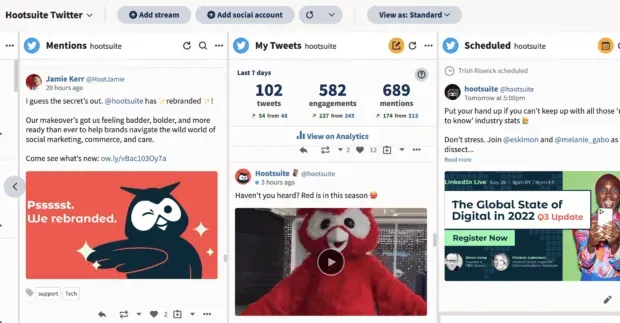
The Twitter search feeds in the Hootsuite dashboard let you quickly find and track important conversations, hashtags, keywords, or locations. You can also save search results as streams to return to later or share with team members.
Nick Martin, Hootsuite’s social media listening expert, says:
“Twitter search threads are one of the most underrated features of the Hootsuite dashboard, if you ask me. I have multiple streams set up to query for specific keywords, phrases, or tweets from the accounts I want to follow. This helps me quickly keep track of what’s going on, find interaction opportunities, or identify key customer feedback that I can share with the wider team. I even have a stream that follows popular brand accounts so I can quickly spot trending content and draw inspiration for our own channel.”
Here are our top ten tips for listening to social media, sourced from Hootsuite social media expert Nick Martin.
1. Listen to the right words and topics
Successful social listening is about choosing the most relevant keywords for your brand.
The keywords and topics you track are likely to change over time. Using social listening tools, you will learn what words people usually use when they talk about your business and your industry. You will also begin to understand which ideas are most useful to you.
However, here is a list of important keywords and topics to keep track of from the get-go:
- Your brand and pens
- Name of your product
- Trademarks, product names and handles of your competitors
- Industry buzzwords
- Your slogan and the slogan of your competitors
- Names of key people in your company and those of your competitors (your CEO, spokesperson, etc.)
- Campaign names or keywords
- Your branded hashtags and your competitors’ hashtags
- Non-brand hashtags related to your industry
You should also keep track of common spelling errors and abbreviations for all of the above.
For example, brands like Starbucks use social snooping on their brand names to find and respond to social media posts, even if they are not tagged:
What a delicious choice!
— Starbucks Coffee (@Starbucks) October 19, 2022
And KFC UK clearly tracks a wide range of keywords related to their business, jumping up here at the mere mention of sauce:
— KFC UK (@KFC_UKI) November 9, 2021
2. Listen in the right places
Part of finding out what your audience has to say about you is learning where they are talking. This means building a wide network for your social listening program.
Conversations about your brand or industry on LinkedIn will likely be very different from conversations on Twitter, Instagram, or Facebook. And you may find that people are constantly talking about you on Twitter, but not at all on Facebook.
You need to know where people are talking about you and your industry, and how those conversations differ across networks. This will determine your strategy for joining the conversation through both organic engagement and paid advertising.
3. Narrow your search
Once you’ve determined which terms and networks are important to you, use more advanced search methods to filter your results.
For example, depending on your market, you may want to limit your social media listening efforts by geography. If you’re running a local business in Iowa, you might not care about talking about Greece.
You can also use logical search logic to create more targeted search flows for listening on social media.
4. Learn from competitors
While you never want to copy someone else’s strategy, you can always learn something by listening carefully to your competitors and what other people have to say about them online.
Social listening can give you insight into what they are doing right and what people like about them. But most importantly, you can see where they go wrong and wrong, or when they face criticism in the press or on social media.
For example, Coca-Cola went through a tough period after Cristiano Ronaldo removed two bottles of Coca-Cola from view during the Euro 2020 press conference. Mike’s Hard Lemonade jumped at the opportunity to parody this moment.
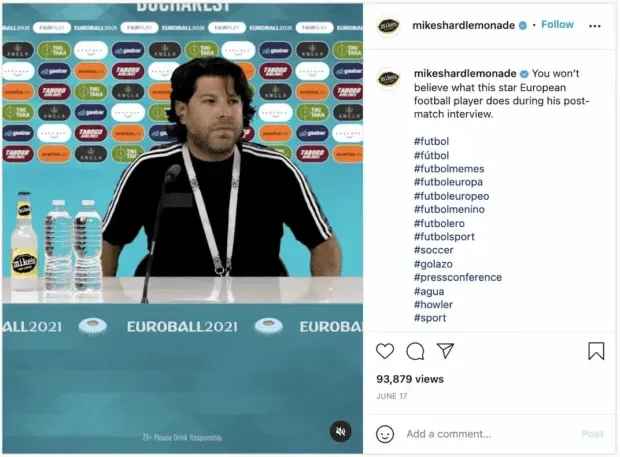
It is far less painful to learn the harsh lesson of watching your competitors make mistakes than it is to make them yourself.
5. Share what you’ve learned
Social listening provides a wide range of information useful to your entire company.
Perhaps this is a customer message that needs an immediate response. Perhaps this is a great idea for a blog post. Or maybe it’s an idea for a new product, or a new feature for an existing product.
Customer service, content marketing, and product development teams can benefit from what you learn from listening to social media posts. Don’t forget to share this knowledge and get input from these teams. They may have specific questions that you could answer by also changing your social listening settings.
6. Be aware of changes
As you start collecting social information, you will develop a sense of regular conversations and sentiment around your brand.
Once you know how many people are talking about you on a regular basis and what the overall sentiment level is, you will be able to notice a change.
Major changes in engagement or sentiment could mean that the overall perception of your brand has changed. You need to understand why so you can tailor your strategy accordingly. This could mean riding a wave of positivity or correcting a gaffe to get back on track.
Hi all! We don’t believe in harming animals to create the perfect product. Period. In fact, we are proud to say that all of our products are not tested on animals worldwide.
— Where (@Where) October 18, 2022
Remember, if you don’t take action, you are only monitoring social media, not listening to social media.
Social listening isn’t just about tracking metrics. It’s about getting an idea of what your customers and potential customers want from you and how you can better meet those needs.
Be sure to analyze patterns and trends over time, not just individual comments. These general ideas can have the strongest impact on your future strategy.
7. False positives are normal, but within reason
When you set up a query to track a specific keyword or phrase, some posts that may not be relevant will show up in the results. We call these false positives.
You can see a few of them, within reason. Work on editing your search term so that most of the results match exactly what you’re looking for and that false positives fall within a reasonable percentage of results.
Nick Martin from the Hootsuite social marketing team is always trying to get false positives below the 5% threshold. This way you better understand what’s going on and false positives (things that are not related to what you’re listening to) don’t skew the data.
Bottom line: A small inaccuracy is acceptable as long as it doesn’t skew the results too much.
Getting started with social listening is a three-step process.
Step 1: Monitor social media channels for mentions of your brand, competitors, products and keywords related to your business using Hootsuite Streams or.
Step 2: Analyze the information to find ways to put what you learned into practice. It could be something as small as reacting to a happy customer, or something as big as changing your entire brand positioning.
Step 3: Track industry hashtags and keywords to see what people are saying about your industry in general.


